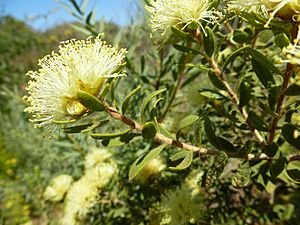Melaleuca ciliosa facts for kids
Quick facts for kids Melaleuca ciliosa |
|
|---|---|
 |
|
| M. ciliosa leaves and flowers | |
| Scientific classification | |
| Genus: |
Melaleuca
|
| Species: |
ciliosa
|
Melaleuca ciliosa is a small, pretty shrub that belongs to the Myrtaceae family, also known as the myrtle family. It grows only in the south-western part of Western Australia, which means it is endemic to that area. This plant is special because it has bright or pale yellow flowers and leaves that are a bit hairy, especially around their edges.
Contents
What Melaleuca ciliosa Looks Like
The Melaleuca ciliosa shrub usually grows to about 1.0 m (3 ft) tall. Its shape can vary quite a lot. The leaves are also different in size, from 4 mm (0.2 in) to 12 mm (0.5 in) long and 2.5 mm (0.1 in) to 6.5 mm (0.3 in) wide. The edges of the leaves are quite hairy. You might also see a few soft hairs on the leaf surface. Many small, clear oil glands are also visible on the leaves.
Flowers and Fruits
The flowers of Melaleuca ciliosa are white or pale yellow. They grow in groups or spikes at the ends of the branches. These branches keep growing even after the flowers bloom. Each group of flowers has 3 to 15 smaller clusters, and each cluster contains three flowers. These flower clusters can be up to 23 mm (0.9 in) across.
A unique part of this plant is its sepals. Sepals are like small leaves that protect the flower bud. In Melaleuca ciliosa, the sepals are joined together. They form a thin, dry ring less than 0.5 mm (0.02 in) wide around the flower's edge. The petals fall off as the flower opens. The stamens, which are the parts that produce pollen, are joined in five bundles. Each bundle has 5 to 11 stamens. This plant usually flowers in October and November.
After flowering, the plant produces woody, cup-shaped or almost round capsules. These are the fruits of the plant. Sometimes they are spread out, and sometimes they form tight bunches up to 2 cm (0.8 in) long.
Naming and History
This plant was first officially described in 1862. It was named by a Russian botanist named Nikolai Turczaninow. He published his description in a scientific paper called Bulletin de la Société Impériale des Naturalistes de Moscou.
What ciliosa Means
The second part of the plant's scientific name, ciliosa, comes from a Latin word, cilium. This word means "fine hair." It refers to the small hairs found on the edges of the leaves of this Melaleuca species.
Where Melaleuca ciliosa Grows
You can find Melaleuca ciliosa growing in sandy areas with heath plants. These areas are located between the cities of Geraldton and Perth in Western Australia. It grows in specific natural areas called biogeographic regions, including the Avon Wheatbelt, Geraldton Sandplains, Jarrah Forest, and Swan Coastal Plain. This plant prefers to grow in sand that has lateritic gravel, often in higher ground.
Conservation Status
The Government of Western Australia's Department of Parks and Wildlife has checked on Melaleuca ciliosa. They have listed it as "not threatened." This means the plant is not currently in danger of disappearing.
Growing Melaleuca ciliosa
This plant can grow well in many different types of soil and conditions. However, it grows best in soil that drains water well and in a sunny spot. If you prune the shrub regularly, it will stay compact and look neat.
Images for kids
-
M. ciliosa growing near the Kalbarri lookout.



